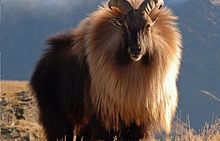
Tahrs or tehrs are large artiodactyl ungulates related to goats and sheep. There are three species, all native to Asia. Previously thought to be closely related to each other and placed in a single genus, Hemitragus, genetic studies have since proven that they are not so closely related and they are now considered as members of three separate monotypic genera: Hemitragus is now reserved for the Himalayan tahr, Nilgiritragus for the Nilgiri tahr, and Arabitragus for the Arabian tahr.

The Himalayan tahr is a large even-toed ungulate native to the Himalayas in southern Tibet, northern India, western Bhutan and Nepal. It is listed as Near Threatened on the IUCN Red List, as the population is declining due to hunting and habitat loss.

Bubalus is a genus of Asiatic bovines that was proposed by Charles Hamilton Smith in 1827. Bubalus and Syncerus form the subtribe Bubalina, the true buffaloes.

The subfamily Caprinae, also sometimes referred to as the tribe Caprini, is part of the ruminant family Bovidae, and consists of mostly medium-sized bovids. A member of this subfamily is called a caprine.

The Bovidae comprise the biological family of cloven-hoofed, ruminant mammals that includes cattle, yaks, bison, buffalo, antelopes, sheep and goats. A member of this family is called a bovid. With 143 extant species and 300 known extinct species, the family Bovidae consists of 11 major subfamilies and thirteen major tribes. The family evolved 20 million years ago, in the early Miocene.
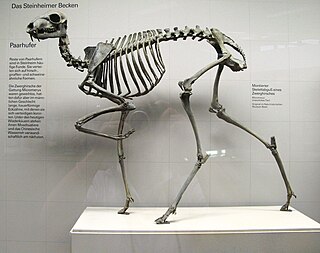
Moschidae is a family of pecoran even-toed ungulates, containing the musk deer (Moschus) and its extinct relatives. They are characterized by long 'saber teeth' instead of horns, antlers or ossicones, modest size and a lack of facial glands. While various Oligocene and Miocene pecorans were previously assigned to this family, recent studies find that most should be assigned to their own clades, although further research would need to confirm these traits. As a result, Micromeryx, Hispanomeryx, and Moschus are the only undisputed moschid members, making them known from at least 18 Ma. The group was abundant across Eurasia and North America during the Miocene, but afterwards declined to only the extant genus Moschus by the early Pleistocene.

The four-horned antelope, also called chousingha, is a small bovid antelope native to central, South and Western India, along with a smaller population in Nepal. The sole member of the genus Tetracerus, the chousingha was first described in 1816 by French zoologist Henri Marie Ducrotay de Blainville. Three regional subspecies are currently recognised. The four-horned antelope has a yellowish-tan, sometimes reddish or goldenrod coat. It is slender with thin legs and a short tail. It stands nearly 55–64 cm (22–25 in) at the shoulder and weighs about 17–22 kg (37–49 lb). Its four horns are unique among antelopes and distinguish it from most other bovids. The longer pair of straight, spike-like horns is atop its head between the ears, while the other, shorter pair is on the forehead; its posterior horns are always longer than the anterior horns, which may even present as merely fur-covered "studs". While the posterior horns measure 8–12 cm (3.1–4.7 in), the anterior ones are usually 2–5 cm (0.79–1.97 in) long.
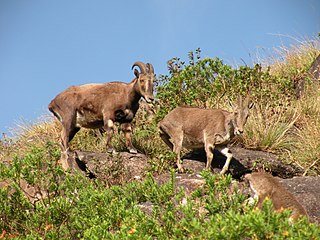
The Nilgiri tahr is an ungulate that is endemic to the Nilgiri Hills and the southern portion of the Western and Eastern Ghats in the states of Tamil Nadu and Kerala in southern India. It is the only species in the genus Nilgiritragus and is closely related to the sheep of the genus Ovis.

Capra is a genus of mammals, the goats, comprising ten species, including the markhor and several species known as ibexes. The domestic goat is a domesticated species derived from the bezoar ibex. It is one of the oldest domesticated species of animal - according to archaeological evidence its earliest domestication occurred in Iran at 10,000 calibrated calendar years ago.

The Arabian gazelle(Gazella arabica) is a species of gazelle from the Arabian Peninsula. There are approximately 5,000 - 7,000 mature individuals in the wild.
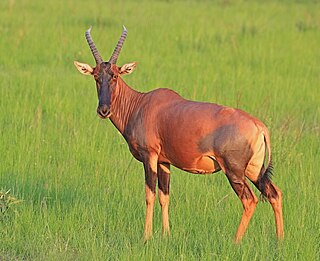
Damaliscus, commonly known as damalisks, is a genus of antelope in the family Bovidae, subfamily Alcelaphinae, found in Africa.

The Arabian tahr is a species of tahr native to eastern Arabia. Until recently, it was placed in the genus Hemitragus, but genetic evidence supports its removal to a separate monotypic genus, Arabitragus.

The tribe Bovini or wild cattle are medium to massive bovines that are native to Eurasia, North America, and Africa. These include the enigmatic, antelope-like saola, the African and Asiatic buffalos, and a clade that consists of bison and the wild cattle of the genus Bos. Not only are they the largest members of the subfamily Bovinae, they are the largest species of their family Bovidae. The largest species is the gaur, weighing up to 1,500 kg (3,300 lb).
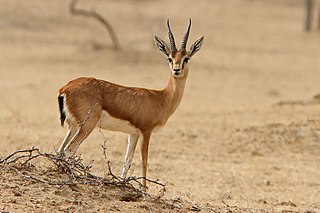
A gazelle is one of many antelope species in the genus Gazella. There are also seven species included in two further genera; Eudorcas and Nanger, which were formerly considered subgenera of Gazella. A third former subgenus, Procapra, includes three living species of Asian gazelles.
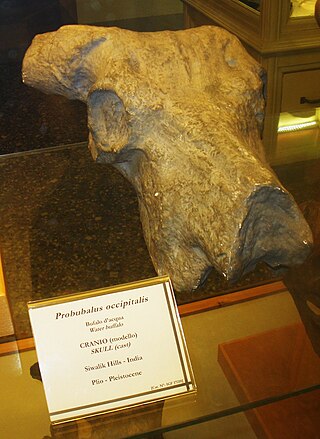
Hemibos is an extinct even-toed ungulate, belonging to the family Bovidae. Its fossil remains were found across Asia and Europe, including findings from China, the Italian Peninsula, the Iberian Peninsula, the State of Palestine, Israel, Pakistan, and India.
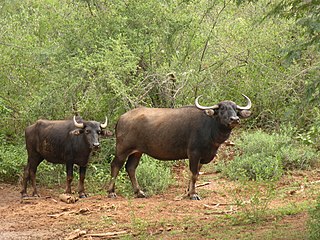
Bubalina is a subtribe of wild cattle that includes the various species of true buffalo. Species include the African buffalo, the anoas, and the wild water buffalo. Buffaloes can be found naturally in sub-Saharan Africa, South Asia and Southeast Asia, and domestic and feral populations have been introduced to Europe, the Americas, and Australia. In addition to the living species, bubalinans have an extensive fossil record where remains have been found in much of Afro-Eurasia.

Urva is a genus comprising the Asian mongooses within the mongoose family Herpestidae. Species in the genus were formerly classified in the genus Herpestes, which is now thought to comprise exclusively African mongooses; phylogenetic evidence indicates that the Asian mongooses form a monophyletic group and had an Asian common ancestor. Urva forms a clade with Xenogale and Atilax, while Herpestes forms a clade with all other African mongoose species.
Hemitragus cedrensis is an extinct species of bovid known from the Eemian of France and the Iberian peninsula.
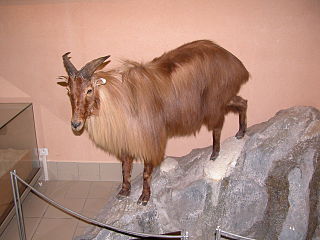
Hemitragus bonali, the Bonal tahr, is an extinct species of bovid from the Pleistocene of Europe and the Caucasus Mountains region.
Budorcas churcheri is an extinct species of takin that lived in the Pliocene of Ethiopia. Its remains were found in the Hadar Formation.
